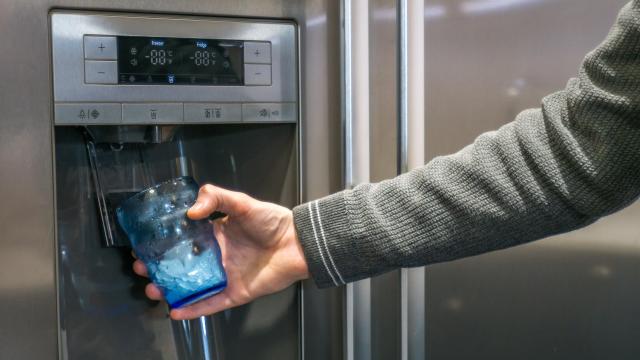The water dispenser on your fridge is a modern convenience that many of us take for granted. Usually, it tastes better than the tap and it’s perfectly chilled. But sometimes, the dispenser can develop issues that cause the water to taste funky, even if the fridge itself is new. Here are some potential causes and simple fixes you can try to troubleshoot the issue before calling in a professional.
Stagnant water in the reservoir
If water has been sitting stagnant in the system for a few days or more, it can affect the taste. If you’ve been out of town for the weekend, or just haven’t been using the water dispenser regularly, try running the water into a larger container for a few minutes, then pour more into a clean glass to check whether the taste has improved.
A filter that needs to be replaced
If that didn’t work, the next thing to check is the filter. Most water filters for refrigerators are either underneath, behind the grill of the fridge, or in the back right top corner inside the fridge. If the filter is worn out, not properly installed, or leaking, that can cause water quality issues. Depending on what type of filter you have, you will either slide its compartment open to remove it or slide the filter directly out, and follow the manufacturer instructions to change it. The most common reasons for funk-tasting water are mould, bacteria, or mineral buildup.
Dirty hoses and reservoir
If the filter is new and properly installed and there’s still a problem, there are still a few things left to try. Another cause of less-than-fresh water is the hoses and reservoir inside the fridge — these can be cleaned, as well. To clean out your system, first unplug the fridge and shut off or disconnect the water line. The water source will be a valve, usually behind the refrigerator. Then, open up the reservoir, usually behind a drawer near the bottom of the fridge. If you have an ice maker, disconnect the line to the ice maker with a screwdriver. Then, take the reservoir out and empty it.
You can clean it with a one-part vinegar to four-parts water solution, then flush the reservoir out with water before replacing it. Use a funnel to run vinegar through the water lines to the ice maker, and run vinegar through the water dispenser, as well. Make sure to have a container ready to catch the vinegar so you can discard it. Next, run clean water through the water lines for a few minutes, then reassemble the housing.
Corroded water valve
At this point, you should also check the valve that controls the flow of water to the fridge and the water lines that carry water from the valve to the fridge system. If these are old, corroded, or dirty, they could be to blame for the bad water. You’ll need to shut off the water line to the house to replace the valve. Some homes have a shutoff inside, but if not, you’ll need to shut off the main to the house. Then, you’ll need a wrench, some teflon tape, and a new valve and hose to complete the replacement. Make sure you screw the new valve on securely so it doesn’t leak.
Bad taste from straight the source
The problem could also be that your water from the source itself contains something that isn’t being filtered out by the fridge system. These filters are intended for chlorine, volatile organic compounds, and other contaminants, but don’t necessarily work for heavy metals, sediment, or other minerals. If your tap water tastes off straight from the source, you might need to install a reverse osmosis filter to improve it.
These can be installed in-line with your water line and are relatively simple to add. In addition to making your water taste better, a reverse osmosis system will remove up to 99.1% of lead from your drinking water, making your water safer to drink. If you live in an area where lead is a concern, a reverse osmosis system is a great choice.

Leave a Reply
You must be logged in to post a comment.